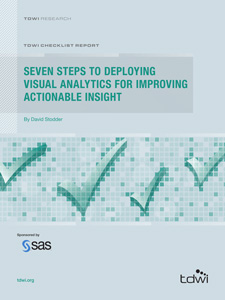
TDWI Checklist Report | Seven Steps to Deploying Visual Analytics for Improving Actionable Insight
March 15, 2013
With data growing in volume and diversity, users need analytical
tools that will help them avoid drowning in a deluge of information.
Data visualization can make a difference by providing graphical
and interactive features and functions necessary for visual
analytics. Visualization types range from primitive bar charts to
histograms, heat maps, scatterplots, and more. Integrated with
powerful underlying analytic data management that prepares data
sets drawn from multiple sources and runs analytic operations
against the data, visualizations such as these enable nontechnical
users to find relationships, discover correlations, and uncover
business-changing insights.
Although visualization is important for all types of business
intelligence (BI) and analytic application deployments, including
highly centralized systems, it is vital for meeting growing user
expectations for “self service”—that is, the ability for users to
work independently of IT to perform ad hoc data discovery and
create dashboards and other visual interfaces on their own. Even
though the freedom of self-service BI and analytics is alluring,
organizations are finding the most success in using a managed
approach. This mode applies software and best practices to guide
users toward understanding data and analytics and determining
the best visual elements with which to convey and share insights.
Visual analytics options are evolving as organizations seek to
include cloud deployment for cost-effective scalability and serve
users interested in BI and analytics functionality on mobile
devices. Cloud initiatives can help in scaling visual analytics to
large numbers of users; rather than install software, organizations
can provide access through Web browsers. Mobile device
deployments must take advantage of native features such as the
ability to swipe, pinch, zoom, rotate, and pan across reports and
graphics. Mobile deployments must also support robust analytics
through Web access to analytic data management systems. Both
cloud and mobile options can help organizations provide users with
faster speed to insight.
This TDWI Checklist Report details seven steps for successful
visual analytics intended to help organizations develop strategies
for improving actionable insight to a growing population of users.